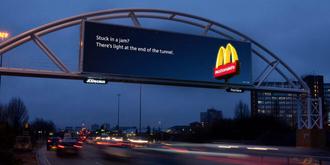In online advertising, metrics data are well-known indicators of successful marketing campaigns. Browser tracking cookies and a variety of tools allow for easy collection and analysis of data relating to user behaviour. An administrator can see how visitors arrived to their website and what they did while on the site with very little effort.
Analytics are useful in the world of digital out-of-home as well, but the manner in which metrics are tracked is a little different.
Measuring impressions
The most important metric in digital out-of-home is the number of impressions that a screen gets over a given time period. Determining how many impressions a screen gets, however, is a little tricky. With online advertising, one appearance of an ad on one screen is likely to reach one person. DOOH, however, is a one-to-many medium. Several people are likely to be looking at a screen at any given moment, meaning that one play of an ad needs to be counted as several impressions.
Determining the impression multiplier, or number of impressions one ad play should count for, requires data collection. Different networks rely on different tools to get this data. Cinemas, for instance, can use ticket sales to get a good idea of how many people see a given ad up on the screen. Other businesses might use cameras and sensors integrated with a DOOH analytics platform like Quividi or Linkett to collect views data on an ongoing basis. Still others might use an independent third-party research firm like Geopath or Nielsen to conduct a statistical analysis of the likely views that a screen will get.
Whatever the method or methods chosen, it’s a critical step for network owners to ensure that this type of information is gathered. It’s only by obtaining an accurate estimate of how many views a screen gets that DOOH media can be fairly priced.
Metrics & pricing
There are three main ways that DOOH inventory is sold:
- CPM, or cost per thousand impressions. With this model, the publisher will negotiate a rate with the advertiser, charging them that rate for every 1,000 impressions they want their ad campaign to get. Note that because of impression multipliers, it is likely that it will take fewer than 1,000 plays to achieve 1,000 impressions.
- Share of voice, or as a proportion of total inventory. When buyers want to be able to purchase a specific percentage of all the ad inventory on all of a network’s or area’s screens, they can do so with this pricing model.
- Loop frequency. DOOH media typically plays on a loop, with much of the same material recurring after a set amount of time. To reach more people, buyers may want to purchase multiple slots within a single loop.
Impression data are at the heart of all of these models, but other metrics can also be important. For loop frequency purchases, for instance, buyers may want to know the dwell time, or amount of time individuals spend in proximity to a screen. If the dwell time is short, buyers may opt for quicker repetitions, in order to reach a wider audience. If it is long, they may want to have a longer buffer between plays, to avoid hitting the same people with the same campaign over and over.
Networks that want to accommodate different purchasing preferences need to have the necessary data to sell these models correctly. Accurate metrics tracking, then, isn’t just a best practice that helps network owners unlock the full value of their screens and inventory. Rather, it ought to be seen as a necessity for conducting transactions.
Conversion attribution and DOOH
Online, it’s easy to attribute a conversion to the channel that brought in a new customer. This is thanks to cookie tracking and the unique online identifiers associated with individual users and their devices. Marketers can look for trends in this data to better understand which channels do the best job of closing sales.
The digital out-of-home space generally relies on a simpler method of tracking the effectiveness of a DOOH campaign. Often, they compare conversions for a product or service before, during, and after a campaign’s run.
That’s not to say that metrics tracking can’t deliver value for DOOH conversion attribution. Impression tracking, for instance, is of great value at this stage. It allows a more granular understanding of the relationship between how many people saw an ad and any uptick in conversions. Further, some DOOH networks tap into mobile location data to better correlate impressions with sales. On the data side of things, this can be great, though it is important to note that privacy concerns could make this sort of data collection difficult.
This reflects an important truth. Digital out-of-home, much like other digital advertising, is currently in a period of growth and restructuring. With metric tracking sure to remain an integral part of digital out-of-home campaigns, DOOH players will need to stay on top of industry shifts in data collection over the coming years.









